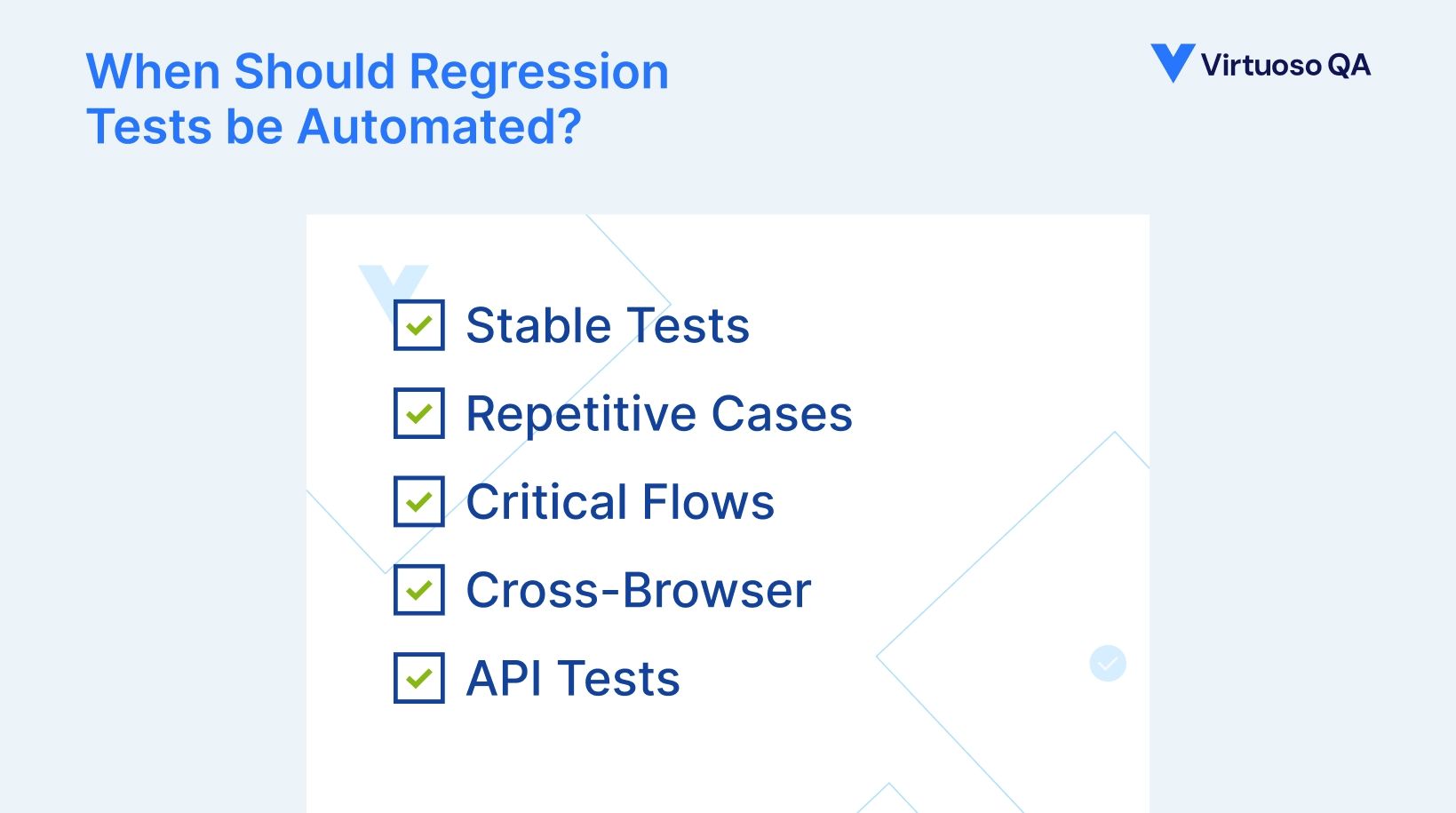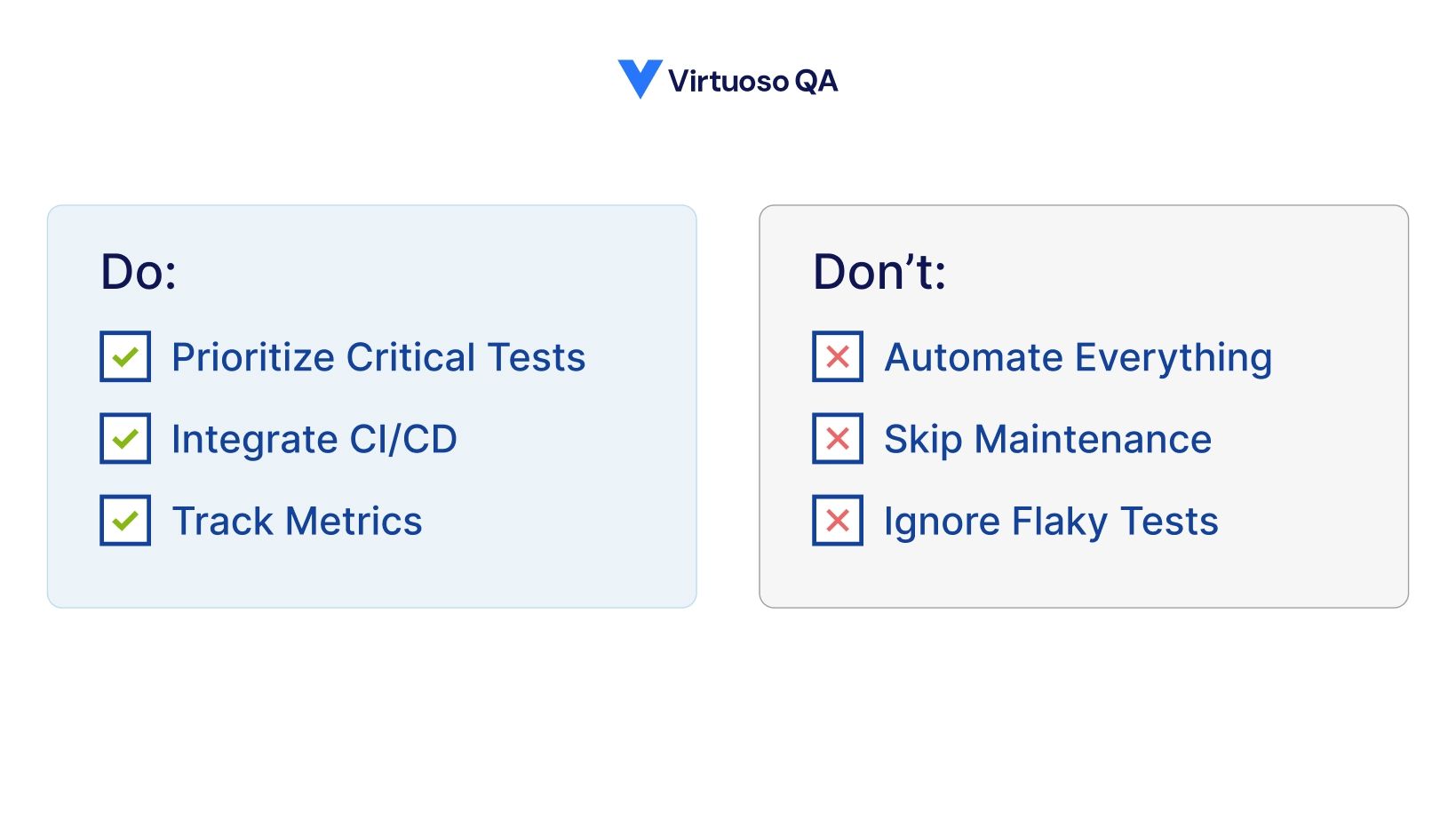
See Virtuoso QA in Action - Try Interactive Demo

Automated regression testing uses software tools and frameworks to execute regression test cases without the need of any human intervention.
Software evolves constantly. Every bug fix, feature enhancement, and code refactoring carries an inherent risk: breaking functionality that previously worked perfectly. This is where regression testing becomes your safety net, and automation transforms it from a time-consuming bottleneck into a strategic accelerator.
In this comprehensive guide, you'll discover everything about automated regression testing: what it is, why automation is essential, how to implement it effectively, and how modern AI-powered platforms like Virtuoso QA are revolutionizing regression testing for agile teams.
Regression testing is a type of software testing that verifies existing functionality continues working correctly after code changes. When developers fix bugs, add features, or refactor code, they risk introducing new defects or breaking previously working features. Regression testing catches these unintended consequences before they reach production.
Regression testing answers the critical question: Did our changes break anything that was working before?
The term "regression" literally means going backward. In software context, regression occurs when application quality decreases because changes inadvertently break existing functionality. Regression testing prevents this backward movement in quality.
To understand how visual aspects of your application are validated during regression cycles, explore our guide to visual regression testing.
Without regression testing, each release becomes a gamble. With comprehensive regression testing, teams release with confidence knowing existing functionality remains intact.
Automated regression testing uses software tools and frameworks to execute regression test cases without human intervention. Instead of manually clicking through workflows repeatedly, automated tests run programmatically, validating that existing functionality continues working correctly after code changes.
This approach transforms regression testing from a manual, labor-intensive process into a fast, reliable, automated validation that happens continuously throughout development. Automated regression tests can execute thousands of test cases in minutes, providing immediate feedback on whether changes maintain application stability.
Automated regression testing enables modern Agile and CI/CD pipelines where code changes occur frequently and releases happen multiple times daily. Without automation, testing simply cannot keep pace with the velocity of modern software development.
The case for automating regression testing is compelling and straightforward. Manual regression testing cannot meet the demands of modern software delivery.
Manual regression testing consumes enormous time. Testing even medium-complexity applications manually can take days or weeks for each release. As applications grow, manual regression becomes impractical.
Automated regression tests execute the same validations in minutes or hours instead of days or weeks. This time savings compounds with each release cycle, delivering massive efficiency gains.
A regression suite that takes two weeks manually might execute in two hours when automated, a 42x improvement in speed.
Speed-to-market provides competitive advantage. Organizations shipping features faster respond to customer needs more effectively and capitalize on market opportunities quickly.
Automated regression testing removes the testing bottleneck that traditionally delays releases. Fast, reliable automated regression validation enables teams to release confidently and frequently, supporting continuous delivery and rapid iteration.
Humans make mistakes, especially during repetitive tasks. Manual regression testing suffers from:
Automated tests execute identically every time, eliminating human error and inconsistency. When an automated regression test passes, you know precisely what was validated and can trust the results completely.
As applications grow in complexity and size, regression test suites expand proportionally. Manual execution becomes increasingly impractical and eventually impossible at scale.
Automated regression testing scales effortlessly. Adding more test cases to automated suites doesn't require hiring more testers. Parallel execution across cloud-based grids enables running hundreds or thousands of tests simultaneously.
Manual testers performing repetitive regression testing represent underutilized talent. These skilled professionals could provide much greater value through exploratory testing, test design, and automation development.
Automating regression testing frees QA engineers from repetitive execution, allowing them to focus on high-value activities like:
Not all regression tests deserve automation. Strategic automation focuses effort on tests providing maximum value.

Automate regression tests for stable functionality that changes infrequently. Tests for features under active development require constant updates, making automation premature.
Ideal automation candidates have:
Tests that run repeatedly provide maximum automation ROI. If you execute a test case once per release, manual execution may suffice. If you run it daily or multiple times per day, automation delivers substantial value.
Prioritize automating:
Business-critical functionality deserves comprehensive automated regression coverage regardless of execution frequency. The cost of defects in revenue-generating or customer-facing features justifies automation investment.
Prioritize automating regression tests for:
Validating functionality across browsers, devices, and operating systems creates exponential test combinations. Manual cross-platform testing becomes prohibitively expensive.
Automated regression testing excels at cross-platform validation:
Backend services and APIs change frequently. Automated regression testing catches integration breakages immediately:
Implementing automated regression testing successfully requires systematic planning and execution.
Tool selection significantly impacts automation success. Consider these factors:
Popular options include:
Not every test case deserves automation. Prioritize based on:
Stable, Repetitive, High-Value Flows: Focus on tests that run frequently, cover critical functionality, and remain relatively stable over time.
Apply these criteria:
Framework architecture impacts maintainability and scalability. Common approaches include:
Automated regression tests deliver maximum value when integrated into continuous integration and deployment pipelines:
Jenkins, GitHub Actions, GitLab CI: Configure pipelines to trigger automated regression tests automatically when developers commit code, create pull requests, or deploy to test environments.
Pipeline integration ensures:
Strategic test execution balances comprehensiveness with speed:
Automated tests require ongoing care to remain effective:
Choosing the right tools dramatically impacts automated regression testing success.
Virtuoso QA represents the next generation of automated regression testing:
Selenium remains the most widely-used open-source automation framework:
Modern JavaScript-based framework gaining popularity:
Microsoft's cross-browser automation solution:
Build automation tool commonly used with Java-based testing:
Testing frameworks providing structure for test execution:
Leading open-source automation server:
Following established best practices maximizes automated regression testing effectiveness while avoiding common pitfalls.

Strategic automation focuses resources where they provide maximum value. Don't attempt to automate everything blindly.
Focus automation on:
Avoid automating:
Test maintainability determines long-term automation success. Poorly designed tests become technical debt that consumes resources without providing value.
Maintain automated tests through:
Optimal regression testing strategically combines both approaches:
Automate stable, repetitive regression flows that execute frequently in CI/CD pipelines.
Manual test exploratory scenarios, usability evaluations, and rapidly-changing features where automation overhead exceeds value.
The goal is not 100% automation but rather optimal resource allocation between automated and manual approaches.
Automated regression tests deliver maximum value when integrated into continuous delivery pipelines:
Measure what matters to drive continuous improvement:
Modern AI-powered no-code platforms dramatically accelerate automated regression testing adoption:
Understanding common challenges enables proactive solutions that prevent automation initiatives from failing.
Automated regression testing requires upfront investment:
Solution: No-code platforms like Virtuoso QA dramatically reduce setup costs through intuitive interfaces, minimal training requirements, and rapid test creation. ROI typically arrives within 6-12 months as execution efficiency compounds.
Traditional automated tests break when applications change:
Solution: AI-powered self-healing automation eliminates 70-85% of maintenance burden. Virtuoso QA automatically adapts tests to application changes, keeping regression suites current with minimal manual effort.
Regression tests can fail inconsistently due to environmental issues rather than actual defects:
Solution: Robust test design with proper wait strategies, test isolation, and stable test data management minimize flakiness. Modern platforms incorporate intelligent stability features that handle timing issues automatically.
Comprehensive regression testing requires managing diverse test datasets:
Solution: Dedicated test data management tools, synthetic data generation, and containerized test environments simplify data management significantly.
Teams must decide how much to automate given finite resources:
Solution: Apply risk-based prioritization focusing automation on high-value, frequently-executed tests. Monitor ROI metrics and adjust strategy based on results. Accept that some tests are better suited for manual execution.
Modern development methodologies transform how regression testing integrates into software delivery.
Agile teams test continuously throughout sprints rather than in distinct testing phases:
Shift-left moves testing earlier in the development lifecycle:
Parallel test execution accelerates regression validation:
Regression testing integrates seamlessly into deployment pipelines:
Framework architecture significantly impacts automation success, maintainability, and scalability.
Keyword-driven frameworks abstract test actions into reusable keywords:
Data-driven frameworks separate test logic from test data:
Hybrid frameworks combine keyword-driven and data-driven approaches:
Model-based testing generates tests from application models:
Modern AI-powered platforms represent the future of regression testing:
Measuring automated regression testing effectiveness requires tracking relevant metrics that drive improvement.
How much faster do automated tests execute compared to manual regression?
What proportion of regression scenarios are automated?
How effectively do automated regression tests find real defects?
How often do tests fail due to test issues rather than actual defects?
What return are you getting on automation investment?
Learning from common automated regression testing mistakes helps teams succeed faster.
Complete automation is neither achievable nor desirable:
Solution: Target 70-80% automation coverage for stable regression scenarios while maintaining manual testing for appropriate use cases.
Automated tests require ongoing care to remain effective:
Solution: Schedule regular test maintenance, leverage self-healing platforms, monitor test health metrics, and retire obsolete tests promptly.
Poor test data management undermines automated regression testing:
Solution: Invest in test data management tools, establish data refresh processes, use synthetic data generation, and containerize test environments.
Automated regression tests disconnected from development workflows provide limited value:
Solution: Integrate automated regression testing deeply into CI/CD pipelines with automatic triggering, clear quality gates, and fast feedback loops.
Teams flying blind cannot improve effectively:
Solution: Establish automation dashboards, track key metrics, review trends regularly, and use data to drive continuous improvement.
Automated regression testing has evolved from a specialized discipline practiced by automation experts into an essential capability accessible to entire development organizations. Modern AI-powered platforms democratize automation, making comprehensive regression testing achievable without specialized programming skills.
The benefits are undeniable: faster releases, higher quality, reduced costs, and increased confidence. The traditional barriers of high maintenance overhead and technical complexity have been shattered by self-healing AI and no-code platforms.
Virtuoso QA delivers intelligent, no-code regression automation designed for fast-moving teams. AI-powered self-healing tests adapt automatically to application changes, reducing maintenance by up to 85%. Natural language test creation enables non-technical team members to contribute to automation. Seamless CI/CD integration provides continuous regression validation without friction.
Key advantages of Virtuoso QA for automated regression testing:
Organizations embracing modern automated regression testing gain competitive advantages through confident, frequent releases and exceptional software quality. The question is no longer whether to automate regression testing but rather how quickly you can implement intelligent, self-healing automation that scales with your business.